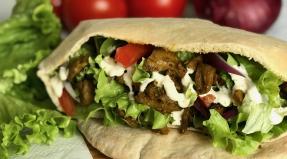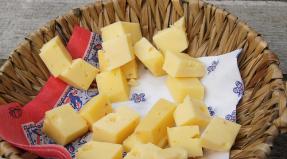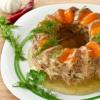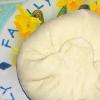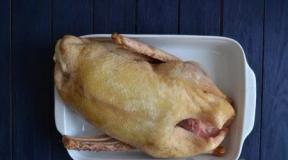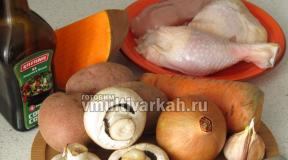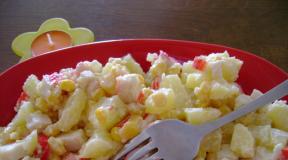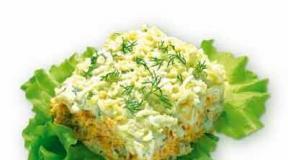How to clean small shrimp. How to peel king prawns
Shrimps, like any seafood, are famous for their high content of iodine, calcium and protein. Undoubtedly, you need to consume them for food, and for this you should be able to properly clean them.
Only the freshest products can bring maximum benefit, and this, of course, also applies to shrimp. The freshly caught product has practically no smell, it is distinguished by a moist and elastic carcass. Such a shrimp has a tail, and a head, and legs are always in place and hold well, its color is gray-green, without white bloom. If the insides in the head area are black, this is a sign of damage. Ideally, the head should not differ in color from the entire body or have a red-orange tint. If there is no access to fresh shrimp, you have to purchase frozen ones. It is safer (and cheaper) to buy unpeeled king prawns. In this case, it is possible to assess the condition of the product by the color of the head. Having chosen cleaned carcasses, we rely only on the conscience of the manufacturer. The contents of the pack are of poor quality if there is snow or a large amount of ice glaze.









Correctly peeling a king prawn means eating a high-quality, extremely healthy product. And this is the path to health and longevity.
Shrimps are representatives of crustaceans that live in the seas and oceans. Their meat, tender and sweet in taste, is highly valued by gourmets all over the world. Features of the preparation of this seafood depend on its size and pre-processing.
- shallow and deep water;
- gray, pink, striped;
- brindle;
- royal;
- serrated;
- carabineras and many others.
Outwardly, they differ in size and color. It is believed that the smaller the crustacean and the colder the water of its habitat, the tastier it is. However, many gourmets are delighted with large king or tiger prawns, fleshy and presentable in appearance. On the Russian shelves, most often there are crustaceans caught in the Far East, as well as in the countries of Southeast Asia and Thailand.  Frozen shrimp covered with ice glaze
Frozen shrimp covered with ice glaze
Regardless of the place of catch and type, most often shrimp are sized by size and packaged in packages marked with two numbers: 50/70, 35/40, etc. This indicator indicates the number of individuals per 1 kg, and not their size as many consumers believe. The smallest specimens can be 90–120 pieces. in 1 kg, and the most "weighty" - only 2 pcs.
Depending on the degree of pre-treatment of shrimp (or lack of it), the following types of shrimp are distinguished:
- alive;
- chilled;
- fresh frozen;
- boiled-frozen.
The most delicious and healthy shrimp are, of course, freshly caught. If you do not live in a fishing region, then you are unlikely to be able to buy live or fresh chilled shrimp. The fact is that crustaceans deteriorate very quickly fresh. The allegedly chilled product in the hypermarket was most likely simply thawed. If the shrimp are still living in the store's aquarium, then they are definitely fresh.  Shrimp is a perishable product, so it is best to buy them live or frozen.
Shrimp is a perishable product, so it is best to buy them live or frozen.
The best option for residents of central Russia are frozen crustaceans. They can be frozen immediately after being caught or after express cooking. Both options are considered relatively safe.
When choosing shrimp, pay attention to external signs:
- the shell should be evenly colored, without light or dark spots;
- the head of the shrimp may be greenish (due to feeding on plankton) - this is not a sign of spoilage;
- it is better to refuse shrimp with a black head, they may turn out to be tasteless or spoiled;
- fresh shrimp are usually gray, translucent, boiled - pink or orange;
- thawed or chilled shrimp has a faint fishy smell, if the seafood smells unpleasant, it may be spoiled.
Preparation for cooking
Rinse live and chilled shrimp under running water before cooking. If you have fresh frozen crustaceans at your disposal, you need to defrost them by placing them in a pot of cold water. It is not necessary to use the microwave, soak in warm water or defrost for a long time at room temperature - this may adversely affect the taste of the product. Boiled-frozen crustaceans can be thawed at room temperature.  After defrosting, the weight of shrimp can significantly decrease.
After defrosting, the weight of shrimp can significantly decrease.
Large shrimp, some cooks prefer to clean before cooking, removing the shell and intestines. If this is not done at the preparatory stage, it is possible that the boiled product will be bitter. Do not throw away raw legs and shells - you can cook broth from them. Small shrimp are usually cleaned after cooking, while boiled-frozen ones can be sold already peeled.
How to cook
Shrimps do not tolerate prolonged heat treatment. If you cook them too long, they will lose their flavor and the meat will become tough. For this reason, shrimp are boiled in boiling water for several minutes. The duration of cooking directly depends on the size of the crustaceans.  The best seasoning for boiled shrimp is fresh lemon juice
The best seasoning for boiled shrimp is fresh lemon juice
Shrimps go well with lemon, it gives them juiciness and piquancy. Lemon juice can be added to the water for cooking and / or pour over the juice of already boiled crustaceans.
Live and chilled shrimp
Crustaceans that have not been subjected to heat treatment are usually gray, greenish or brownish in color.  Fresh shrimp are grey, brownish or greenish in color.
Fresh shrimp are grey, brownish or greenish in color.
To properly weld them, proceed as follows:
- Boil water in a saucepan (about 2 liters of water are taken for 1 kg of shrimp).
- Add spices - salt, bay leaf, pepper, juice of half a lemon to taste.
- Place the shrimp in a saucepan and bring the water to a boil.
- Cook for about 3 minutes (large shrimp - 5-6 minutes).
- Readiness is determined by appearance - crustaceans become pink or matte.
fresh frozen
If the shrimp were frozen fresh, after defrosting they have the same color as the live ones. The cooking method is no different from the preparation of live and chilled crustaceans.
Boiled-frozen
These crustaceans are ready to eat, you just need to defrost them and hold them in boiling water for a very short time to warm them evenly.  Small boiled-frozen peeled shrimp are called salad
Small boiled-frozen peeled shrimp are called salad
Long cooking will make the meat "rubber" and almost tasteless. Proceed as follows:
- Throw the thawed shrimp into boiling salted water (spices to taste).
- Hold for no more than 1-2 minutes.
- Turn off the heat and immediately remove the shrimp from the water with a slotted spoon.
How to clean shrimp
Crustaceans are easy to clean after cooking. You can do this immediately before use (peel one at a time and eat immediately) or in advance (to add to other dishes). The method for cleaning small shrimp is simple:
- Take the shrimp by the head and turn it upside down.
- Carefully pry off the legs.
- Separate the head from the body.
- Grasp the shell and pull it, easily removing it from the entire surface of the back.
In large shrimp, it is also necessary to remove the intestine, which is located inside the crustacean and looks like a dark thread. Clean them up like this:

In the same way, you can clean large shrimp before cooking.
Video: shrimp cutting secrets
In order for the shrimp to turn out tasty and tender, it is important to choose a quality product, process it correctly and not overexpose it in boiling water. Ready-made shrimp can be an independent snack or become an ingredient in a wide variety of dishes.
The inhabitants of the deep sea have always been considered delicacies that are served on the table as a luxurious treat for guests.
Seafood is recommended by nutritionists instead of meat for those who want to keep their figure.
Shrimp is certainly considered one of the most popular and consumed shellfish.
There are many varieties on the market, they usually differ in size and color. How to properly clean shrimp? After all, for each dish you need only peeled meat. Let's figure it out.
How to clean raw shrimp
Cleaning raw or cooked shrimp involves a few simple steps. Whatever type of shrimp you buy, cleaning them will not be difficult.
So let's start in order:
1. Rinse the shrimp. Place the shrimp in a colander and rinse thoroughly with cold water.
2. Inspect the shrimp and discard any that will be slimy, dull and smell bad.
3. Cleaning raw shrimp should begin with tearing off the head (if any). To do this, squeeze your head between your index finger and thumb, only where the body already begins. Hold your body firmly on the other side. Start twisting your head clockwise until the head comes off.

4. Then remove the shell, starting at the wide end and moving towards the tail. The legs will come off with the shell. The tip of the tail can be left for a more presentable look. But if you still need to remove the tail, just press on it and squeeze it out of the meat.
5. After the shrimp, you need to cut and remove the intestinal tract (dark vein along the body). Using a sharp knife or scissors, make an incision in the center of the outer curve, about a third of the length of the torso. This is how you can remove the intestinal tract of the shrimp. The easiest way to do this is with a toothpick. Slicing gives a more attractive appearance, as they curl slightly and come off when cooked.

Thanks to this, the shrimp dish should not be bitter. Next, rinse the shrimp in cold water and dry on a paper towel. The shrimp is ready for cooking.
How to clean frozen shrimp
How to properly clean shrimp, we sorted it out. But some may wonder if there are any features of cleaning frozen shrimp. Let's figure it out, because some features still exist.
Before you start cleaning frozen shrimp, first of all, you need to rinse them thoroughly under cool water. After on a napkin or towel, dry a little. Stir the dried but still frozen shrimp into a deep bowl and sprinkle with coarse salt. We wait a couple of minutes and start. Since in most cases, frozen shrimp are already sold without a head, we will skip this step.
How to clean frozen shrimp:
1. Rinse the product under cold water until they are completely melted.
2. Carefully, so as not to tear off the meat, we begin to remove the shell. To do this, the shell must be cut and the plates removed. If the shrimp is large, do it carefully and slowly, as it is more likely to tear off the meat.
3. We remove the intestines in the way we already know, but this must be done slowly (in thawed shrimp, the intestinal tract can easily break).
After all the procedures, the shrimp are washed again under running water and dried with a towel. You do not need to wrinkle them when drying, just gently blot them with a dry towel or napkin.
How to properly clean shrimp? This question worries everyone who first encountered a similar product. Here we got it right. But how to choose the right shrimp is an important question. After all, the taste and aroma of the cooked dish will depend on the quality.
Of course, it is best to buy them live from a special aquarium, but this is not always and not always possible. The second option is frozen shrimp. When buying them, it is important to carefully consider the appearance of each individually. Properly processed shrimp should not be stuck together. The legs and tails are held close to the body, and the head should be green or brown. Ice on each carcass should be minimal so that it seems as if the shrimp is enclosed in the thinnest coating. The presence of snow and pieces of ice in the bag as a whole is unacceptable.
How to use removed shrimp shells
And finally, one more piece of advice. After cleaning raw shrimp, do not rush to throw away the shells. From them you can make a wonderful soup or an exotic sauce. Put them in a saucepan. Pour in enough water to just cover the shells, bring to a boil, and simmer over low heat for 30 minutes. After you need to remove the pan from the heat, strain the contents and start cooking soup on the broth of shrimp shells.
Shrimps are not only tasty, but also incredibly healthy seafood. Their meat is rich in nutrients and trace elements that have a positive effect on the entire body. Shrimps can be served as an independent dish or as an ingredient adding sophistication to the meal. In any case, no matter how you serve them, the crustaceans must first be cooked and cleaned. Cooking them is easy, but not everyone knows how to peel shrimp.
Oddly enough, but dissatisfaction with the final dish may arise just because of a technical violation during the cleaning of shrimp, because the food may contain a not very pleasant smell or specific taste.
Before proceeding to the release of carcasses from the shell, they must be boiled. Thanks to heat treatment, undesirable components can be avoided from getting into the meat. It is advisable to buy crustaceans unpeeled, so they retain their juice and maximum useful properties. And buying unpeeled shrimp is usually more profitable because of the smaller amount of frozen ice.
How to properly clean fresh and boiled shrimp
Some recipes call for the shrimp to be cleaned prior to cooking. In this case, the shell can be removed from them as follows: you need to take sharp scissors and carefully cut the chitinous shell, trying not to touch the meat. The shell is cut in the direction of the tail, after which each plate is carefully removed. Be careful, as the scales are translucent and you can skip them without distinguishing them from the edible pulp.
After that, the intestinal vein is carefully removed; with the right approach, it will separate entirely without bursting. If the shrimp is large, then it will be enough to pull, but with small ones this number will not work, their vein is very thin and easily torn - it would be better to cut it out.
Do not tear off your head, if it does not contradict the recipe, since a large number of useful substances are found in it. During the cooking process, they make the meat softer and more tender.
Ready-made shrimp are easy to peel: you need to turn the belly up, carefully tear off the legs along with the eggs, if any, and then remove the head. Holding the shrimp by the tail, you can easily remove the shell.

How to clean frozen shrimp
Before you start cleaning frozen shrimp, you should first dip them in cool water, rinse, put on a dry surface and blot with a napkin. Next, place the crustaceans in a bowl with high sides and sprinkle with salt with large granules, wait five minutes and start cleaning. Again, you need to immerse them in cool water and wait until they are completely thawed.
After that, the protective layer should be cut, removing the plates and paws. Be careful with large carcasses, do not damage them by accidentally tearing off a piece along with the shell. When finished cleaning, rinse the carcasses one more time and let the water drain into a colander.

If everything is done correctly, then the final dish will turn out to be very fragrant, tasty and healthy. It only takes a little practice in cleaning shrimp, and any method will be elementary.
Shrimp have ceased to be a curiosity for a long time. Today you can find them in almost every supermarket. The cost of shrimp is also quite acceptable, so anyone can buy them. The only burning question associated with eating shrimp is how to clean raw shrimp, as well as how to properly clean an already cooked product?
How to choose?
There are about 2000 varieties of shrimp in the world. Don't worry, memorizing these species and their names is optional. It will be enough to understand that there are warm-blooded shrimp that live in the warm sea, and cold-blooded shrimp, which in turn prefer to live in cold seas. The largest varieties, which include tiger and king prawns, are warm-blooded. Such seafood comes from Asia, Thailand, Indonesia and China.
Smaller product is brought from Norway, Denmark and Estonia. By the way, the price will also depend on the size of the shrimp, that is, the larger the seafood, the more expensive it is. In European countries, seafood is subject to special sanitary control, but this cannot be said about Asia.


Important! Small individuals are much more useful than large ones.
By the way, for some reason, most shrimp lovers believe that it is much more profitable to buy an already peeled product. That's just not the case. If you know how to properly clean unpeeled shrimp, there will be less waste. At the same time, self-peeled and cooked shrimp will turn out to be much healthier, and even tastier.
When choosing this product, you should pay attention to several nuances.
- Information provided by the manufacturer. It must contain complete information about the contact details and phone numbers of the manufacturer.
- To help you navigate the size of the product will help such a parameter as caliber. For example, if 1 kg is indicated on the package - 120/150, therefore, in one kilogram of seafood there are only 120-150 pieces. When a product is offered for purchase without a head, the manufacturer usually indicates the caliber at 450 g of weight.
- A shrimp with a tucked tail, even and smooth color is considered an ideal product. An old product can be recognized by a dry shell, dark spots and dots located on the paws. The staleness of the product also gives away the yellowish color of the meat. If you see a shrimp with an uncurled tail, most likely it was already frozen dead.
- There should be no snow or ice inside the bag itself. If there is still ice or snow in the package with shrimp, this only says one thing - the seafood has been repeatedly frozen.

You also need to pay attention to the shade of the head. Brown-headed shrimp are the healthiest because they are pregnant. Gray heads are also not bad - these are ordinary individuals. Green heads indicate that the shrimp ate only one kind of plankton. It is strictly forbidden to buy and even more so to eat black-headed shrimp, since such individuals were prone to some serious diseases.

Important! The best choice would be small frozen gray-brown shrimp with bent tails.

Cleaning methods
A purchased delicacy can be purified in several ways. Whichever variety you choose, you need a knife to clean the seafood, and you should also prepare scissors, a bowl for peeled shrimp and for cleaning
Step by step guide for the manual method
Peeling shrimp by hand is considered a classic way. It is worth adhering to the algorithm described below.
- Before cleaning, seafood must be boiled and then cooled. Now you can remove the heads, legs, which are collected in a bundle, and then gently and evenly pulled out. You don't need to delete parts.
- Next, proceed to the separation of meat from the shell. You need to do this towards the tail, starting from the head. By the way, it is not necessary to remove the tails, you can leave them. For example, if rolls are being prepared, this is considered the most popular decoration. In this way, you can decorate other dishes, because it looks very original.


- In cleaning shrimp, the most difficult task is to remove the intestinal vein. When it bursts, an unpleasant aroma and bitterness appears. You need to pull out the intestinal vein slowly with your fingers in order to remove it whole, and not in parts. If you do everything carefully, do not rush, the result will be juicy pulp.
- The legs and heads of the shrimp are cut off, an incision is made on the top of the back, right in the middle, moving slowly down, you need to continue to cut the shell to the end. Both parts of the shell are removed from the tails, along with which the hard peritoneum should be removed. When the intestinal vein cannot be seen, a small incision is made on the back. The vein can be located at a depth of 0.5 cm
Important! In large individuals, there are two such intestinal wreaths - on the back and on the peritoneum.
Starting from the lowest segment, the shell is separated. Here it is desirable to turn the shrimp, but very carefully to remove the whole thing. At the very end, the tail is removed, it must be torn off in the same way as the head. We must not forget about the intestines with the ventricle. The wreath is hooked with a knife and carefully pulled out. For easier removal from a small specimen, an incision can be made along the entire back without damaging it. Such skill can be mastered after several independent cleanings. Then there will be no more problems.
For information on how to properly clean shrimp, see the video below.
